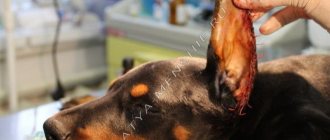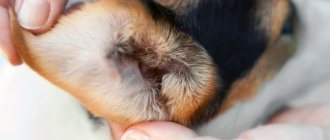Often dog owners have to deal with such a problem as neck disease in their pet. The fact that your pet’s ears hurt is not difficult to notice by the behavior of your dog: he often begins to scratch his ears with his paws, shake his ears, and various kinds of discharge appear from his ears. Moreover, an unpleasant odor emanates from these secretions.
Ear disease is most common in those breeds of dogs that have long floppy ears - setters, dachshunds, Afghan hounds, spaniels, beagles, etc. And this is due to the fact that the ears of such dogs often lie on the floor and are poorly ventilated.
Causes of ear disease in dogs.
- Ear mites.
- Inflammation of the middle ear.
- Inflammation of the outer ear, including otitis externa.
- Allergic and skin diseases.
- Trauma in the ear area, incl. ear hematoma.
- Foreign bodies that enter the dog's ear while walking (dry grass, plant seeds, etc.) initially lead to irritation of the delicate skin of the ear and the development of inflammation.
- As a result of bacteria, viruses, fungi and yeast entering the ear canal.
- Disease of the endocrine glands (hypothyroidism).
- Various types of hereditary and immune diseases, as well as cancer.
Ear diseases
This disease is usually common among lop-eared dog breeds; inflammation of the outer ear is especially common in hunting dogs due to the fact that they have to swim a lot during hunting.
The disease in dogs is accompanied by itching in the area of the auricle, as a result of which the dog strongly scratches its ears with its paws or rubs them on various objects. The disease is accompanied by swelling and sometimes eczema in the ear area. An unpleasant specific smell comes from the ears, which has a sickly sweet or fetid aroma. Upon examination, we note redness and swelling of the external auditory canal. A sick dog loses its appetite, and sometimes its body temperature rises. There are two types of discharge in dogs - serous and purulent.
TOP 10 causes of ear tumors
The most commonly affected dog breeds are those with floppy ears. This is explained by poor ventilation of the dermis and the fact that pronounced pathology is often hidden from the owner until the last.
The dog's ear is swollen, due to which:
- Ear mite.
- Otitis (inflammation of the outer ear).
- Allergic reactions (including to food).
- Traumatic injuries (hematomas).
- Foreign bodies.
- Bacteria, fungi, yeast (malassezia).
- Hypothyroidism (poor functioning of the endocrine glands).
- Oncological diseases (benign and malignant neoplasms).
- Immune pathologies, congenital anomalies.
What exactly is the reason behind the swelling of the ear and changes in the dog’s well-being - the veterinarian will tell you after examination, examination, and tests. Treatment depends on the diagnosis, degree of complication, course of the disease and involvement of periarticular (adjacent) tissues in the pathological process.
Inflammation of the middle ear in dogs
Inflammation of the middle ear in a dog occurs, most often as a result of an infection from the outer ear entering the eardrum, as well as as a result of local and general infection in the dog (canine distemper).
The disease in a dog is accompanied by pain when opening its mouth, difficulty chewing, sometimes there is discharge from the eyes, strabismus, the dog may twist towards the affected ear. A sick dog's body temperature rises and its appetite disappears. If complications occur, the dog may experience meningitis or inflammation of the vestibular apparatus, accompanied by incoordination of movement.
Symptoms: what to look out for?
When a dog has a swollen ear, along with swelling, there may be other signs:
- Behavior change.
- Severe or mild discomfort.
- Tilt of the head to one side (permanent).
- Sudden changes in behavior (apathy, aggression, if you hurt your ear).
- Myositis, unilateral overstrain of the neck muscles (with prolonged head tilt).
- Nervousness, insomnia, anxiety.
- Anorexia.
When there is pain in the ear, itching, the dog constantly fiddles with it, scratches it, and whines or squeals if it strongly touches the inflamed tissue with its claw. With certain diseases, there may be specific discharge, from serous to purulent, with an unpleasant odor.
Important! If you notice a swollen ear in a dog or one or more symptoms, contacting a veterinary clinic is mandatory. A timely diagnosis and treatment will reduce the likelihood of complications and, in certain cases, eliminate death.
Ear mites in dogs
The most common ear mite in dogs is otodectosis. The disease is accompanied by itching, the sick dog shakes its head, scratches its ears on various objects or tries to comb the affected areas of the skin with its paw claws. Subsequently, as the inflammatory process in the auricle develops, first serous and then purulent-ichorous exudate begins to be released from the ear canal, which, when flowing out, sticks together the hair of the lower edge of the auricle. This exudate, when dried, forms scabs and crusts of gray or light brown color on the inner surface of the ears, as well as in the external auditory canal. When the eardrum is perforated, a sick dog's appetite worsens, body temperature rises, the dog develops bow-headedness, nervous attacks and convulsions.
The diagnosis of otodectosis is made based on the symptoms of the disease, which must be confirmed by the results of a microscopic examination of scrapings from the inner surface of the skin of the ears, for the presence of the mite – Otodectes cynotis.
Among mites, canine demodicosis can cause ear disease in dogs.
Dangerous symptoms
Otitis itself is already dangerous in that gradually the inflammation can go further. It can damage the inner ear, permanently deprive one of hearing, or even spread to the brain, but the reasons that provoked it are also important. You can determine exactly how bad the animal’s situation is only by analyzing all the symptoms.
The most dangerous are considered:
- Unpleasant odor coming from the ears.
- Constant urge to scratch the affected area.
- The dog constantly shakes his head.
- Increased body temperature.
- Loss of coordination.
- Walking in circles.
- Epileptic seizures.
- Gradual loss of vision.
- Lack of response to the owner's voice or other loud sounds.
- Standing still.
- Permanent “facing the wall” position
If you consult a doctor promptly when you first notice fluid leaking from your ears, you can avoid further development of the disease and have time to treat it before the consequences become irreversible.
Allergic otitis media in dogs
Allergic otitis in dogs often occurs as a result of an allergic reaction to the food consumed or as a result of a hormonal imbalance in the dog's body.
This type of otitis in a dog is accompanied by abundant secretion of sulfur from the external auditory canal and intensive proliferation of fungi in the microflora. In a dog, allergic otitis media is accompanied by itching; the dog unsuccessfully tries to stop it by scratching its ears with its paws. As a result, the dog develops scratches and ulcers, as well as brown discharge that has a purulent consistency. For more information on this topic, see our article on food allergies in animals.
Drugs used
Let us immediately warn you that almost all the drugs used (described below) can in one way or another be dangerous for the dog. Therefore, they can only be used after consultation with a veterinarian!
Ear drops
The following ear drops can be used:
- Otipax (medical drug, very effective).
- Framycetin.
- Sofradex.
These drugs are not only quite cheap, but also have a pronounced anti-inflammatory and analgesic effect. They can be instilled only after preliminary cleaning of the ear canal from exudate and other contaminants. After applying the medicine, the base of the ear is thoroughly massaged.
Suspensions
The following suspensions are used in veterinary practice:
- Otimix.
- Otoxolan.
- Isotik.
- Posatex.
Note that all of the above suspensions are produced in the form of the same drops, and therefore are used in exactly the same way.
Antibiotics
The following antibiotics are used to treat otitis media in dogs:
- Lincomycin (must be diluted with a 0.5% novocaine solution, the injection is extremely painful).
- Ceftriaxone and other drugs from the cephalosporin group.
- Amoxiclav.
- Gentamicin. If possible, it is better not to use it due to its high toxicity.
Ear hematoma in dogs
An ear hematoma in a dog occurs as a result of mechanical damage to the large blood vessels located in the delicate ears of dogs. A hematoma in a dog can occur as a result of scratching the ear with claws, or from the bites of another dog. In lop-eared dog breeds, hematoma can sometimes occur from shaking their long ears. With a hematoma, bleeding occurs in the vessels in the ear, between the cartilage and skin (on the outer surface of the ear) or between the cartilage and the perichondrium (on the inner surface of the ear).
A hematoma on a dog’s ear appears quite quickly shortly after injury. The auricle becomes thickened or swollen, the ear loses its inherent elasticity and sag. And a dog with erect ears has all the corners of his ears hanging down. In its initial stage, the hematoma is hot upon palpation, and upon visual examination the skin is reddened and bluish. A dog's hematoma itches and bothers it. Such a dog shakes its head or tilts its head to the side of the damaged ear, trying to reach it with its paws. Three days later, on palpation at the site of the hematoma, due to the accumulation of air, crepitus appears (the ear seems to crunch). After a few more days, with a small hematoma, the veterinarian notes its thickening and decrease in pain. If the hematoma is large, then the dog’s ear begins to rot.
Possible consequences and complications
We list the possible consequences and complications of otitis media:
- Complete or partial deafness.
- Death due to sepsis or purulent brain damage.
- Neurological pathologies against the background of encephalitis and meningitis.
- It has been noticed that dogs who have had otitis media once often experience relapses.
Ear eczema in dogs
Ear eczema in dogs appears as a result of a variety of external irritants that have a harmful effect on the dog’s ears. Irritants can be: dust, various chemicals, pollen, water, sulfur, etc. Sometimes eczema in dogs can be a concomitant complication of diseases that are caused by tick or flea bites.
When affected by eczema, the dog scratches and shakes the ear that is affected by eczema and becomes irritable. On examination, the affected ear is red and swollen. When examined on the surface of the auricle, you can sometimes find bubbles that burst when pressed, releasing a light or brown liquid. The auditory canal of a sick dog is sometimes filled with foul-smelling exudate.
Treatment at home
Typically, treatment at home is allowed only in cases where the animal’s condition is stable and does not cause any concern. The following treatment regimen is usually practiced:
- The ears and the skin around them are washed from dried exudate with chlorhexidine. It is recommended to trim the hair in these areas (especially for long-haired pets).
- Drops prescribed by a veterinarian are instilled into the ear and/or ointments are applied.
- Antibiotics or other antimicrobial/antifungal drugs are given orally.
- To relieve inflammatory processes, anti-inflammatory corticosteroids are prescribed.
- If the dog feels unwell, sedatives and painkillers are used.
- If the cause of otitis is otodectosis, insecticidal agents are used.
- When the disease is allergic, antihistamines are used.
Diagnosis of ear diseases in dogs
As with other diseases of domestic animals, the diagnosis of ear diseases in dogs is carried out comprehensively.
When visiting a veterinary clinic, diagnosis of the disease begins with a clinical examination of the sick animal.
*During a clinical examination, the veterinarian uses an otoscope to examine the external auditory canal. During the examination, the specialist carefully examines the cavities of the outer and middle ear, assesses the condition of the eardrum, skin, and the presence of swelling. During the examination, the veterinarian excludes the presence of foreign bodies, spinous processes of grass, and ticks in the ear canal. When performing an otoscopy, the veterinarian can register exudate from the outer ear, redness of the skin, pain at the base of the ear on palpation, bulging of the eardrum into the canal area - all this tells the specialist about swelling in the middle ear cavity.
*Laboratory tests, including:
- A general blood test to determine, among other things, whether the dog has allergies. To exclude hypothyroidism, a blood test is performed to determine the amount of hormones - thyroxine and triiodothyronine.
- To study microflora, diagnose tumors, autoimmune diseases, hyperplasia of the sulfur gland and determine microflora for sensitivity to antibiotics, cytological analyzes of secretions secreted from the ear are carried out in a veterinary laboratory.
- Microscopy of skin scrapings and ear gland exudate is performed for the presence of mites, pathogenic microorganisms and signs of autoimmune diseases.
*If, during laboratory research, the veterinarian did not receive the necessary data to make a diagnosis. Then in veterinary clinics they resort to radiography, with the help of which a specialist can detect tumors and polyps of the nasopharynx, leading to chronic otitis.
*In large veterinary clinics, your sick dog can undergo computed tomography and magnetic resonance imaging. Using these research methods, a veterinary specialist can obtain more complete data about the condition of the middle ear cavity in a dog and the possibility of involvement of neighboring organs, including the brain, in the inflammatory process.
Having made a diagnosis of otitis media, the veterinarian prescribes appropriate treatment for the sick dog.
Diagnosis of the cause of inflammation
Since the prescribed treatment depends on the root cause of otitis media, correct diagnosis of the cause of inflammation is extremely important:
- The veterinarian performs a thorough visual examination of the affected ear. So, in particular, it is possible to detect a foreign body, wounds, and other “mechanical” causes of the development of otitis media.
- Otoscopy. This is a visual examination of the ear canals up to the eardrum using an otoscope.
- A blood test is required, since its results can be used to judge the severity of the inflammatory process.
- Tissue scrapings and exudate samples are taken. They are subjected to microscopic examination, and also seeded on nutrient media in order to accurately identify the direct causative agent of the disease.
- If there is a suspicion of fungal otitis (especially in advanced cases), either an x-ray or an ultrasound is done, ideally an MRI. These studies are urgently needed to determine the extent of ear tissue destruction. With serious fungal infections, even the bones of the skull are often affected.
Purulent otitis media in dogs
Treatment of this form of otitis begins with freeing the ear canal from accumulated exudate. In the case when pus accumulates behind the eardrum and puts pressure on it, and also when, during the examination, the veterinarian discovers visible abscesses, it is necessary to make a small incision and clean the ear cavity of purulent exudate, and treat the wound with an antiseptic. In mild cases of purulent otitis, the veterinarian is limited to local treatment - Otipax, Fugentin, Tsipromed, Normax, etc. In severe cases of the disease, in addition to local treatment, antibiotics are used, based on the results of titration of the inflammatory exudate carried out in the veterinary laboratory for sensitivity to a particular antibiotic (amoxicillin, ampicillin, oxytetracycline, cephalosporin drugs, etc.).
In order to maintain immunity and speed up recovery, the dog is given medications such as Gamavit, Immunofan, Ribotan, Vitam, Fosprinil and other vitamin preparations.
To relieve pain in the ear canal area, medications such as Otipax and Framycetin are used. These drugs additionally have a good anti-inflammatory effect.
Treatment of otitis media
Treatment of otitis depends on the causes that caused it (both primary and secondary).
1. For parasitic otitis, antiparasitic drops are used on the withers 2 times with an interval of 3 weeks and daily sanitation of the ear canal is carried out. When parasitic otitis is complicated by a secondary bacterial or fungal infection, specific local (in advanced cases - systemic) therapy is carried out.
2. For allergic and other otitis, the root cause is eliminated, and local (in severe cases systemic) antibiotics or antimycotics are used together with local anti-inflammatory therapy and daily sanitation of the ear canal.
3. Treatment of verrucous (warty) otitis, which develops with long-term otitis, comes down to the use of conservative and surgical methods.
Prevention of ear diseases in dogs.
Prevention of ear diseases in dogs is based on preventing the causes that can lead to ear diseases in dogs.
- Clean your dog's ears regularly to remove dirt and dust.
- When bathing your dog, be careful not to get water into your dog's ears. If water gets into the ears, they must be dried using a towel or cotton swabs.
- It is advisable to cut off the existing long hair in the dog’s ears so that it does not get into the dog’s ears.
- It is necessary to prevent the dog from becoming hypothermic while walking, etc.
- Avoid exposing your dog to other dogs that have ear mites or ear diseases.
Carefully observe the rules of personal hygiene of the dog (Dog Care). Check your ears regularly for signs of inflammation.
Types of discharge
One of the easiest ways to determine if your dog is suffering from an ear infection is to check the discharge around the ears. There are different colors and smells. Understanding the differences and what they mean can help your best friend get better faster. Here's a simple guide to the types of discharge you may experience.
© shutterstock
Black and granular discharge
How to recognize : Look for a discharge that resembles coffee grounds around your dog's ears.
What it means : Black, granular discharge is usually a sign of ear mites, which can also cause ear infections in dogs, and in this case it is common for their ear to leak.
Treatment : You need to get rid of ear mites as soon as possible. To do this, you will need an ear wash, cotton balls or swabs, rubber gloves, and ear mite medication. Clean your dog's ears twice a day until the discharge and ear mites are gone. This can be an unpleasant task, so do it in an open space and with clothes that are easy to wash. If you suspect your dog already has an ear infection, use trusted products to ensure proper care.
Smelly yellow to green discharge
How to recognize it : This type of discharge can range from yellow to green, but you'll really know it because of the foul odor that's hard to miss.
What it means : This may indicate that your dog has a bacterial ear infection.
Treatment : A bacterial ear infection can be treated at home using natural products. Due to the rapid growth of bacteria, you should address this as soon as you realize there is a problem. Treatment usually takes about 12 days, but you will see improvement in just three days. If you don't notice any changes within 72 hours, your dog may need antibiotics. If this happens, it is best to visit a veterinarian. Otherwise, bacteria may spread.
Dark brown discharge and strong odor
How to recognize : In this case, you will see a dark brown discharge coming from your dog's ear, but what you will most notice is a strong, fermentation-like odor.
What it means : This is often a sign of a fungal infection caused by yeast. This may occur after exposure to excessive moisture, such as swimming. To prevent fungal infections, dry your dog's ears thoroughly after water activities, especially if your dog has long, floppy ears, which can trap moisture and lead to infections.
Treatment : You should take almost the same steps as you would for an ear mite infestation. Clean your dog's ears twice a day until the discharge stops and the smell disappears.
© shutterstock
Establishing diagnosis
In case of discharge and pain in the ears, you should always consult a doctor so that an accurate diagnosis can be made.
At worst, untreated ear infections can become chronic and affect the patient for the rest of their life. A number of studies and tests are offered to make a diagnosis. The doctor will first check your medical history to determine which symptoms are present. He will then examine the ear canal more closely using an ear mirror (otoscopy), whereby he will visually examine the inner ear using an ear specula. Inflammation, with local hyperemia or bulging of the eardrum, is noticeable even during the initial examination.
If necessary, the ENT doctor can additionally check the mobility of the eardrum and how well the Eustachian tube functions.











